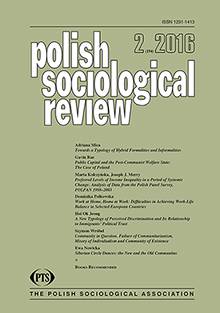Public Capital and the Post-Communist Welfare State: The Case of Poland
Public Capital and the Post-Communist Welfare State: The Case of Poland
Author(s): Gavin RaeSubject(s): Social Sciences, Sociology
Published by: Polskie Towarzystwo Socjologiczne
Keywords: welfare state; post-Communist; Poland;capital; countermovement;Bourdieu; Polanyi
Summary/Abstract: This paper provides an overview of some of the main theories of the welfare state. It builds upon Polanyi’s theory of the double-movement and relates this to Bourdieu’s concept of multiple capitals. It argues that the welfare state can be understood as a form of public capital, both in an economic and sociological sense. The welfare state emerges and is maintained due to a social countermovement that at least partly removes areas of socio-economic life out of commodity relations. In turn this creates public capital, which is both economic and social. In the post-Communist countries most of this public capital was created during a period when almost the whole of economic and social life was controlled by the state. Once the Communist system collapsed, so the accompanying policy of full-employment and system of social welfare organised through state enterprises disappeared.This was met with a large rise in unemployment and labour deactivation, meaning that many social benefits were created during the initial years of the transition. Also, the post-Communist systems inherited large amounts of public capital in the form of public services such as health and education. Through the example of Poland this paper analyses how this public capital was initially maintained and even developed during the early transition period, but then how a process of commodifying it was later begun.
Journal: Polish Sociological Review
- Issue Year: 194/2016
- Issue No: 2
- Page Range: 155-169
- Page Count: 14
- Language: English

